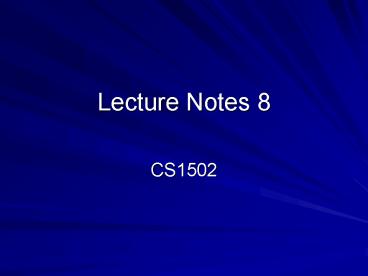Lecture Notes 8 - PowerPoint PPT Presentation
Title:
Lecture Notes 8
Description:
Methods of attack: Boole. Show P is a tautological consequence of (P Q) ... Non-consequence. Show the following argument is invalid. Cube(a) Cube(b) (Cube(c) Cube(b) ... – PowerPoint PPT presentation
Number of Views:46
Avg rating:3.0/5.0
Title: Lecture Notes 8
1
Lecture Notes 8
- CS1502
2
Example Proof
- A ? (B ? C)
- (A ? B) ? (A ? C)
3
(No Transcript)
4
Valid Argument
- P1 P2 Pn Q
- Q is a tautological (logical) consequence of P1,
P2, , Pn - (P1 ? P2 ? ? Pn) ?Q is a tautology (logical
necessity). NEW IDEA
Valid Argument
5
Example
- Show ?P is a tautological consequence of ?(P ?
Q). - Methods of attack
- Boole
- Show ?P is a tautological consequence of ?(P ?
Q). - Show ?(P ? Q) ? ?P is a tautology.
- Fitch
- Show ?(P ? Q) is a valid
argument
6
Tautological Consequence
7
Tautology
8
Using Fitch
9
Example
- Show ?P is not a tautological consequence of
?(P ? Q). - Method of attack
- Boole
- Show ?P is not a tautological consequence of ?(P
? Q). - Show ?(P ? Q) ? ?P is not a tautology.
- Build a world
- Show ?(P ? Q) is an invalid
argument
10
Not a Tautological Consequence
11
Not a Tautology
12
Build a World
- Let P be assigned true and Q false. ?(P ? Q) is
true while ?P is false.
conclusion
premises
13
Example
- Show the following argument is valid.
Cube(b) ?(Cube(c) ? Cube(b)) ?Cube(c)
14
Logical Consequence
15
Logical Necessity
16
Fitch
17
Non-consequence
- Show the following argument is invalid.
Cube(a) ? Cube(b) ?(Cube(c) ? Cube(b))
?Cube(c)
18
Counterexample
19
Inference Patterns
- Modus Ponens P ? Q P Q
20
Tautological Consequence
21
Tautology
22
? Elimination
- P ? Q P Q
? Elim
23
? Introduction
- P Q P ? Q
? Intro
24
? Elimination
- P ? Q P Q
? Elim
25
? Introduction
- P Q Q
P P ? Q
? Intro
26
Inference Patterns
- Modus Tollens P ? Q ?Q ?P
27
Modus Tollens































